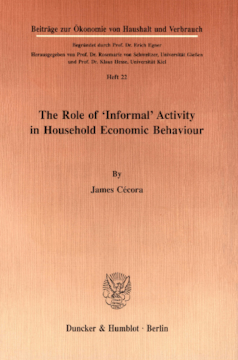The Role of »Informal« Activity in Household Economic Behaviour

BOOK
Cite BOOK
Style
Format
The Role of »Informal« Activity in Household Economic Behaviour
Beiträge zur Ökonomie von Haushalt und Verbrauch, Vol. 22
(1991)
Additional Information
Book Details
Pricing
Table of Contents
| Section Title | Page | Action | Price |
|---|---|---|---|
| Preface | 7 | ||
| Table of Contents | 9 | ||
| 0 Introduction: | 13 | ||
| 0.1 General context of the subject matter | 13 | ||
| 0.2 Objectives and methods of our empirical investigation | 15 | ||
| 0.3 Definition of terms | 16 | ||
| 1 Household Behaviour in Economic Theory | 23 | ||
| 1.1 Three modules: state, enterprises, households | 24 | ||
| 1.2 Factors influencing non-market production by members of private households | 27 | ||
| 1.3 Choice theory and resource allocation | 30 | ||
| 2 Private Households in Public Statistics | 33 | ||
| 2.1 Depiction of households in general administrative statistics: National and international accounts | 33 | ||
| 2.2 Statistical instruments in the Federal Republic of Germany | 36 | ||
| 3 Informal Economic Activity of Private Households in the Light of Empirical Research | 41 | ||
| 3.1 Macro-economic investigations for evaluation purposes in administrative statistics | 42 | ||
| 3.2 Behavioural research on household ‘informal economic activity’ | 44 | ||
| 3.3 Unanswered questions and hypotheses | 49 | ||
| 4 Design and Implementation of a Survey on Household Economic Behaviour and its ‘Informal’ Aspects | 53 | ||
| 4.1 Theoretical concept | 53 | ||
| 4.2 Selection of the survey sample, survey design and implementation | 57 | ||
| 4.2.1 Selection of the survey sample | 58 | ||
| 4.2.2 Survey design and implementation | 59 | ||
| 4.3 Classification and evaluation of survey data | 63 | ||
| 4.3.1 Categories of time-use | 64 | ||
| 4.3.2 Evaluation of time-use | 67 | ||
| 4.3.3 Classification of the income and allocation of nominal and real goods | 70 | ||
| 4.3.4 Evaluation of the income and allocation of nominal and real goods | 70 | ||
| 5 Survey Results | 73 | ||
| 5.1 Utility value and allocation of household income in nominal and real goods from ‘formal’ and ‘informal’ sources | 75 | ||
| 5.1.1 Utility value of household income in nominal and real goods | 75 | ||
| 5.1.2 Household allocation of income in nominal and real goods | 81 | ||
| 5.2 Time-allocation and the utility value of ‘formal’ and ‘informal’ inputs of human capital into household subsistence | 83 | ||
| 5.2.1 Description of time-allocation by members of the survey households | 84 | ||
| 5.2.1.1 Time-input into ‘formal’ gainful activity | 86 | ||
| 5.2.1.2 Time-input into ‘housework’ | 89 | ||
| 5.2.1.3 Time-input into miscellaneous side-activities | 90 | ||
| 5.2.1.4 Time-input into non-domestic ‘informal activities’ | 91 | ||
| 5.2.1.5 Total productive use of time | 92 | ||
| 5.2.2 Utility value of time-use by members of the survey households | 93 | ||
| 5.3 Utility value of owner-occupied residences for household subsistence | 94 | ||
| 5.4 The ‘real consumption’ of the survey households and a review of the contribution of ‘informal’ resources | 94 | ||
| 5.5 Economic behaviour – as described by the ‘subsistence technology’ of private households | 100 | ||
| 6 Summary | 103 | ||
| Literature | 105 | ||
| Appendix | 117 |
